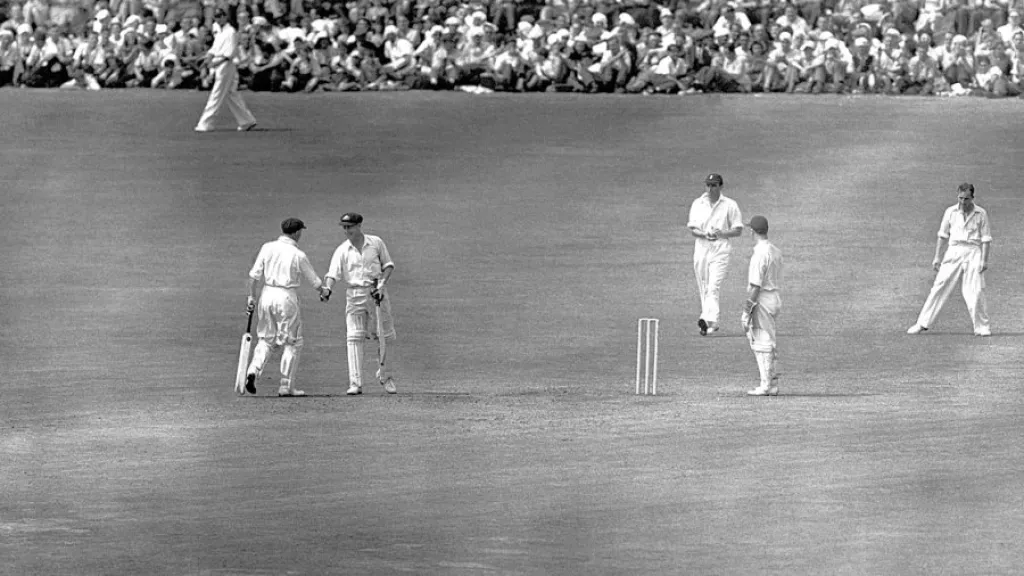The memories of the Ashes cannot be complete without the mention of Bradman’s Invincibles and Jim Lake’s 19 wickets. Here’s the second part of the throwback!
Bradman’s Invincibles (1948)

(Source: Getty Images)
After an eight years gap due to the Second World War, the Ashes had been resumed in 1946-47. England team led by Wally Hammond had visited Australia to play five Tests. The hosts had won the series 3-0 scoreline, thanks to a strong squad led by Don Bradman.
Australia came for the return tour to England only to prove their superiority throughout the visit. During those days such cricket tours were close to six months long with the touring team playing many first-class matches along with the Test matches. In1948, Australia played a total of 34 matches in England tour, 31 of those with first-class status and five out of those were Test matches. Bradman’s Australia won 25 out of those 34 matches and rest nine matches were drawn. Hence the team ended the tour as invincible and the team was referred as ‘Bradman’s Invincibles’.
It was one of the strongest teams ever in cricket history. Don Bradman in his last Test series scored 508 runs with an average above 72. But the top scorer was Arthur Morris with 696 runs at an average of 87. Sid Barnes and Lindsay Hassett also finished with 300 plus runs. The bowling was led by Ray Lindwall and Bill Johnston as both picked up 27 wickets. Keith Miller, the premier all-rounder finished with 184 runs and 13 wickets.
Australia won the Test series 4-0 with wins at Trent Bridge, Lord’s, Headingley and the Oval. The Oval was also the venue for Bradman’s final Test where only four runs were required for a round 100 Test average for the man. But Bradman was bowled on the second ball of the leg spinner Eric Hollies and ended with an astonishing average of 99.94
Jim Laker’s Match

(Source: PA Photos)
By mid-1950s England had taken the upper hand in the Ashes rivalry. They had won the Ashes in 1953 as well as in 1954-55 on Australian soil and wanted to keep their stronghold when Australians returned for the 1956 tour. Jim Laker was England’s premier spinner during the 1950s and his 195 wickets in 46 Test matches put him in the third position in the list of most Test wickets by English spinners. He played 29 of his 46 Tests in England and never toured India and Pakistan to get a chance to bowl in more spin-friendly conditions. However, he still managed to become one of the biggest weapons for England post the Second World War.
In the fourth Test of the 1956 Ashes at Old Trafford, Jim Laker reached cricket immortality with his outstanding bowling effort and his match record is an impossible one to break.
England were given an under-prepared pitch to help their spinners Laker and Tony Lock. Laker took the opportunity by both hands. England batted first and posted 459 runs in their first innings based on the centuries from Peter Richardson and David Sheppard. Australian spinners Richie Benaud and Ian Johnson took combined 6/274.
But once England came to bowl it was a completely different picture. Although openers batted steadily and added 48 runs, once Laker changed his end and started bowling from Stretford end things got better for England. Laker broke the partnership by taking out Colin McDonald and then immediately bowled Neil Harvey with a ball which pitched outside the leg and hit the top of the off-stump. This wicket just before the Tea on day two created a huge impact on the entire Australia team and later was called ‘the ball which won the series’. Post Tea Australian batsmen surrendered meekly to Laker and from 48 for no loss got all out for 84 with Laker finishing with 9/37 and Lock getting the spare one. It was the best bowling performance in an Ashes Test and with a lead of 375 runs, England asked Australia to follow on.
Australia again started solidly and added 53/1 till the end of day two with Harvey getting out for a golden duck off Laker. Day three and day four were rain-affected and a very few overs were possible. By the end of day four Australia were on 84/ 2 with Laker adding Burke’s wicket in his tally. On day five, the rain stopped but on a drying sticky wicket Laker was lethal. He bowled brilliantly and once again ran through the Australian batting line up. From 114/2, the Australian were all-out for 205 with Laker picking up all the 10 wickets. It was a brilliant achievement and shows the kind of control he had on the match.
Australia lost the Test match by an innings and 170 runs and Jim Laker put his name in the record books by picking up 19 for 90. Since then no other bowler could take more than 16 wickets in a Test match and only Anil Kumble could take 10 wickets in an innings against Pakistan in 1999.
This epic performance gave England a 2-1 lead and ensured the Ashes was retained.

